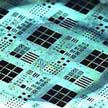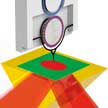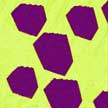Showing Spotlights 865 - 872 of 2878 in category All (newest first):
 Researchers have developed various assembly approaches, including self-assembly and electric/magnetic field directed assembly, to build diverse colloidal matters. These techniques feature high throughput but with limited structural configurations. Specifically, some of the techniques highly rely on the physical performance of the colloidal particles. In new work, researchers have developed a versatile colloidal assembly strategy - termed opto-thermophoretic assembly (OTA) - to build artificial colloidal matter in a wide range of colloidal materials, sizes, and shape.
Researchers have developed various assembly approaches, including self-assembly and electric/magnetic field directed assembly, to build diverse colloidal matters. These techniques feature high throughput but with limited structural configurations. Specifically, some of the techniques highly rely on the physical performance of the colloidal particles. In new work, researchers have developed a versatile colloidal assembly strategy - termed opto-thermophoretic assembly (OTA) - to build artificial colloidal matter in a wide range of colloidal materials, sizes, and shape.
Sep 11th, 2017
 In recent years, researchers working in neurobiology have been intrigued by the idea of microtubule-stabilizing drugs as a therapy to augment nerve regeneration. In new work, scientists show that a better idea is to increase the amount of the dynamic parts of the microtubules. They do this by reducing the levels of fidgetin, a protein that normally exists in nerves to keep the dynamic parts of microtubules from elongating too much.
In recent years, researchers working in neurobiology have been intrigued by the idea of microtubule-stabilizing drugs as a therapy to augment nerve regeneration. In new work, scientists show that a better idea is to increase the amount of the dynamic parts of the microtubules. They do this by reducing the levels of fidgetin, a protein that normally exists in nerves to keep the dynamic parts of microtubules from elongating too much.
Sep 8th, 2017
 There is a proposal for a new legislative framework tailored for nanomaterials and their applications called Registration, Evaluation, Authorization, Categorization and Tools to Evaluate Nanomaterials - Opportunities and Weaknesses (REACT NOW). REACT NOW is the first attempt to present a truly comprehensive and transparent regulatory decision-making framework tailored for nanomaterials. This proposal for new legislative framework combines registration, evaluation, authorization and categorization of nanomaterials.
There is a proposal for a new legislative framework tailored for nanomaterials and their applications called Registration, Evaluation, Authorization, Categorization and Tools to Evaluate Nanomaterials - Opportunities and Weaknesses (REACT NOW). REACT NOW is the first attempt to present a truly comprehensive and transparent regulatory decision-making framework tailored for nanomaterials. This proposal for new legislative framework combines registration, evaluation, authorization and categorization of nanomaterials.
Sep 7th, 2017
 The incidence of food allergies, food sensitivities, and autoimmune reaction is increasing worldwide, particularly among children. Designing a novel device for food testing, researchers have developed a portable, point-of-use technology for rapid, integrated exogenous antigen testing (iEAT). The system consists of a disposable allergen extraction device and an electronic keychain reader for sensing and communication. The extraction kit captures and concentrates food antigens from dispersed food. Captured allergens are then quantified using the miniaturized key-chain reader.
The incidence of food allergies, food sensitivities, and autoimmune reaction is increasing worldwide, particularly among children. Designing a novel device for food testing, researchers have developed a portable, point-of-use technology for rapid, integrated exogenous antigen testing (iEAT). The system consists of a disposable allergen extraction device and an electronic keychain reader for sensing and communication. The extraction kit captures and concentrates food antigens from dispersed food. Captured allergens are then quantified using the miniaturized key-chain reader.
Sep 6th, 2017
 Perovskite materials have attracted great attention in the fields of optoelectronics due to their significant optoelectronic properties. So far, the applications of perovskite thin-films have been limited to solar cells because the required high-definition patterning for optoelectronic devices hadn't been achieved yet. Now, though, researchers in Korea have realized a high-resolution spin-on-patterning (SoP) process for the fabrication of optoelectronic devices arrays such as image sensors.
Perovskite materials have attracted great attention in the fields of optoelectronics due to their significant optoelectronic properties. So far, the applications of perovskite thin-films have been limited to solar cells because the required high-definition patterning for optoelectronic devices hadn't been achieved yet. Now, though, researchers in Korea have realized a high-resolution spin-on-patterning (SoP) process for the fabrication of optoelectronic devices arrays such as image sensors.
Sep 5th, 2017
 The implantation of orthopaedic devices is associated with a high risk of post-operative complications that increases substantially with each revision surgery. Researchers now have proposed a two-pronged strategy to address this outstanding clinical problem by combatting infections and providing bioactivity for titanium implants. Their nanostructured surfaces simultaneously are highly antimicrobial as well as bioactive - the goal of combining both functions without inducing cytotoxicity has thus far proved elusive.
The implantation of orthopaedic devices is associated with a high risk of post-operative complications that increases substantially with each revision surgery. Researchers now have proposed a two-pronged strategy to address this outstanding clinical problem by combatting infections and providing bioactivity for titanium implants. Their nanostructured surfaces simultaneously are highly antimicrobial as well as bioactive - the goal of combining both functions without inducing cytotoxicity has thus far proved elusive.
Sep 4th, 2017
 Photothermal induced resonance (PTIR) has found application in the characterization of materials in fields spanning from photovoltaics, plasmonic, polymer science, biology and geology to name a few. PTIR combines the spatial resolution of atomic force microscopy with the specificity of absorption spectroscopy, enabling mapping of composition and electronic bandgap, material identification and biomolecule conformational analysis with nanoscale spatial resolution. Scientists have now implemented, for the first time, an integrated near-field cavity-optomechanics readout concept to realize fully functional nanoscale AFM probes capable of ultralow detection noise within an extremely wide measurement bandwidth in ambient conditions, surpassing all previous AFM probes.
Photothermal induced resonance (PTIR) has found application in the characterization of materials in fields spanning from photovoltaics, plasmonic, polymer science, biology and geology to name a few. PTIR combines the spatial resolution of atomic force microscopy with the specificity of absorption spectroscopy, enabling mapping of composition and electronic bandgap, material identification and biomolecule conformational analysis with nanoscale spatial resolution. Scientists have now implemented, for the first time, an integrated near-field cavity-optomechanics readout concept to realize fully functional nanoscale AFM probes capable of ultralow detection noise within an extremely wide measurement bandwidth in ambient conditions, surpassing all previous AFM probes.
Sep 1st, 2017
 Molecular ferroelectrics are highly desirable as they are environmentally friendly, light-weight, and high spontaneous polarized. Though intensive studies have been focused on molecular ferroelectrics, very few researchers have tried to address the issue of thin film growth. An international research team now presents the first report on the preparation of high-quality large area MOFE films using in-plane liquid phase growth. With this approach, different kinds of novel ferroelectric films can be grown for potential practical applications such as temperature sensing, data storage, actuation, energy harvesting and storage.
Molecular ferroelectrics are highly desirable as they are environmentally friendly, light-weight, and high spontaneous polarized. Though intensive studies have been focused on molecular ferroelectrics, very few researchers have tried to address the issue of thin film growth. An international research team now presents the first report on the preparation of high-quality large area MOFE films using in-plane liquid phase growth. With this approach, different kinds of novel ferroelectric films can be grown for potential practical applications such as temperature sensing, data storage, actuation, energy harvesting and storage.
Aug 31st, 2017
 Researchers have developed various assembly approaches, including self-assembly and electric/magnetic field directed assembly, to build diverse colloidal matters. These techniques feature high throughput but with limited structural configurations. Specifically, some of the techniques highly rely on the physical performance of the colloidal particles. In new work, researchers have developed a versatile colloidal assembly strategy - termed opto-thermophoretic assembly (OTA) - to build artificial colloidal matter in a wide range of colloidal materials, sizes, and shape.
Researchers have developed various assembly approaches, including self-assembly and electric/magnetic field directed assembly, to build diverse colloidal matters. These techniques feature high throughput but with limited structural configurations. Specifically, some of the techniques highly rely on the physical performance of the colloidal particles. In new work, researchers have developed a versatile colloidal assembly strategy - termed opto-thermophoretic assembly (OTA) - to build artificial colloidal matter in a wide range of colloidal materials, sizes, and shape.
 Subscribe to our Nanotechnology Spotlight feed
Subscribe to our Nanotechnology Spotlight feed





